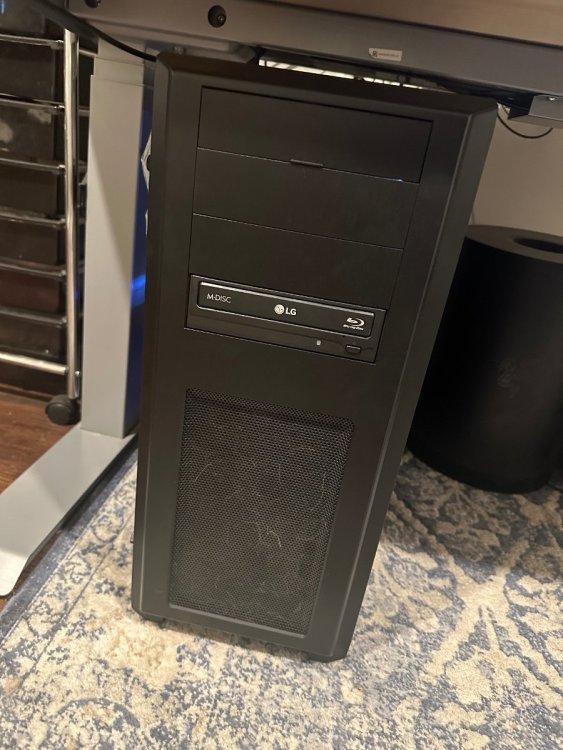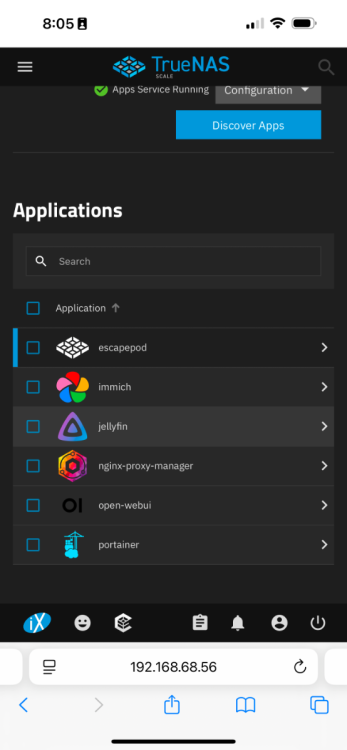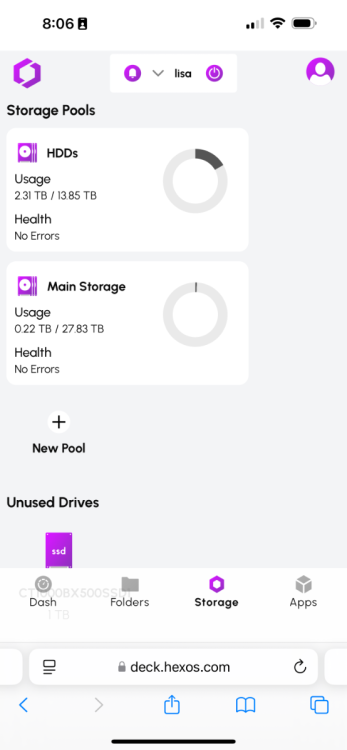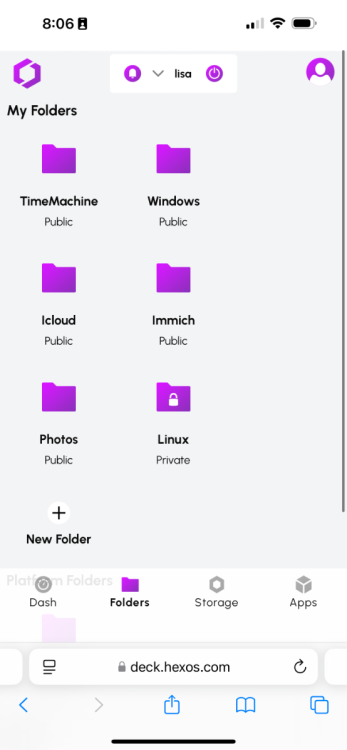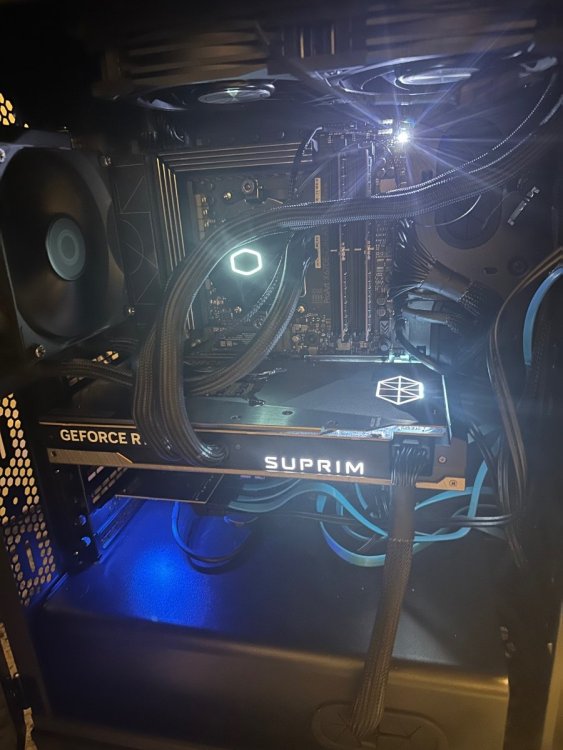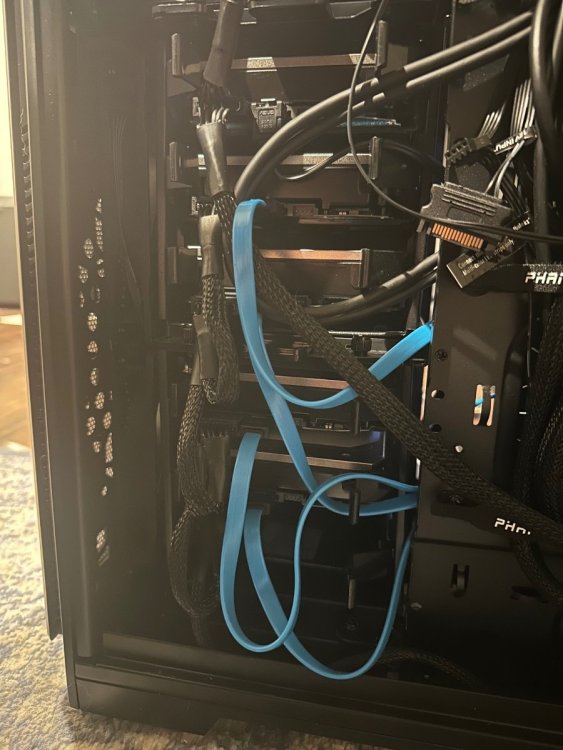Leaderboard
Popular Content
Showing content with the highest reputation on 12/06/24 in all areas
-
I believe integrating Home Assistant with HexOS could be a game-changer for the operating system, offering functionality that is sorely lacking in almost all other OS platforms today. A Home Assistant integration would allow users to monitor and manage their NAS more effectively. Imagine being able to track critical metrics such as system uptime, array health, disk health checks, and the overall status of your storage systems — all from within Home Assistant. Furthermore, adding control features would significantly enhance the user experience. It would be fantastic if users could automate tasks like rebooting or stopping/starting applications, VMs, or containers directly through Home Assistant. Additionally, automating disk spin-downs during off-peak hours for power savings would be a powerful and eco-friendly feature. The potential of Home Assistant integration is vast, and it's difficult to fully capture all the possibilities in a single topic. However, the core idea is simple: having such an integration, with continuous updates and new features, would be a major advantage for HexOS. While most other operating systems either lack similar functionality or offer only basic, limited capabilities, HexOS could stand out by providing a more comprehensive, user-friendly, and flexible solution.3 points
-
3 points
-
Hi there! This will happen server side.3 points
-
Down the Road, it would be really awesome if we would get a curated installation for Paperless-NGX! https://docs.paperless-ngx.com/ Paperless is a really awesome Document Management System for all sorts of things. Paperless have lots of Small Features like full OCR and full in document text search. With a Duplex scanner, you can easly backup ALL of your paper documents and have them automatically sorted - a perfect companion for HexOS that aims to make digital backups a breeze! With a Curated and easy install, it could also help to backup analog paper 🙂2 points
-
I would like to see first party support for placing any app behind some of the most popular VPNs (PIA, Nord, Express, Proton, Tailscale, etc), as well as custom VPNs (WireGuard, OpenVPN, etc). For example, you may install “The Lounge” IRC client and have all internet communication pass through a PIA VPN so that your home IP is not exposed while chatting. Traditional methods of doing this involve painful configuration of iptables or other firewall rules. I believe this is an area where HexOS could really simplify things: Install a VPN plugin, authenticate with it, and then simply assign an app to a VPN plugin via the app’s settings if desired. It would be fully accessible from the home network without going through the VPN, but all internet traffic would go through the VPN with a kill switch in case the VPN goes down. Thoughts?2 points
-
Hey all, similar to what TrueNas offers out of the box as the multi-user Time Machine option, I would like to see Time Machine Backup support for macOS devices. This could be a special type of folder for that special purpose only where settings are locked in and only user access permissions can be set as with any other folder. Hope to see this implemented at some point together with a quick tutorial on how to set up the backup in macOS with automatic drive connection on system start and so on. Would make the whole process of setting it up very easy for everyone. That feature would make HexOS a real alternative to the mac mini as a home server for "all-in on apple" people. Please feel free to ask for clarification and add your ideas!2 points
-
UPDATE: As of 11/8, we have updated the ISO installer to run on version 25.04.2.6 of TrueNAS SCALE. Existing users should NOT reinstall to get this version. You can update from within the Activity card on the Dashboard (or the Notification). Hello and thank you for joining the HexOS beta program! You are an elite and vital part of this project and your participation is greatly appreciated. This post contains all the information you will need to get started with HexOS and how to communicate with our team during your beta experience. Disclaimer Beta Products, Software, and any related Services are still in development, and therefore, you are advised to safeguard important data, to use caution, and not to rely in any way on the correct functioning or performance of the products, software, or any related services. Beta Products and Services are provided to you “AS IS”, without any warranty whatsoever. Expectations During your participation in the beta, we expect you to do the obvious: use and test the software. But we also expect you to communicate with us when things don’t go right or if you’re having trouble. Please post feedback and let us know about your experiences, good and bad. That being said, please remember that this is beta software and early access. HexOS has a long and healthy roadmap ahead. Quickstart Guide For those that just want to get started, here’s the TLDR: Download the ISO here: https://downloads.hexos.com/TrueNAS-SCALE-25.04.2.6-HexOS.iso or https://hexos-downloads.sfo3.cdn.digitaloceanspaces.com/TrueNAS-SCALE-25.04.2.6-HexOS.iso (SHA256 Checksum: e8ed99a322affe0969b82b866161a9f6acbc1561e3cc7b2efb2bf120ffe2e856) Use a tool such as Balena Etcher to image a USB flash device with the ISO. Boot your server from the flash device and install the OS to preferably an SSD. When given the option, opt to create the admin password in the installer (do not select the option to "Configure using WebUI"). Remove the flash device and reboot your server when the install is complete. From another device (mobile, tablet, desktop) that is on the same LAN as your server, login to https://deck.hexos.com using your HexOS credentials. Follow the instructions to complete your server configuration. NOTE: As of the 24.10.2.2 build of this ISO, configuring the admin password via the webUI option has been removed from the installer. However, if you select to create an admin password, but then attempt to "cancel" that process, the ISO will proceed with an installation with no admin password set. This is a known bug and the TrueNAS team will be addressing this in a future update to the ISO. Just don't cancel out of creating the admin password in the installer ;-). Hardware Requirements Booting HexOS is designed to support a wide variety of x86 hardware (Intel or AMD). The minimum requirements are a 2-core 64-bit CPU, 8GB of memory, and a 16GB or larger SSD boot device. However, depending on your needs for performance and applications, more resources may be required. Storage Pools Pools are made up of storage devices based on size and type (HDDs vs. SSDs). Storage devices in each pool need to be roughly the same size*. The OS boot device cannot be a part of a pool. Expandable pools require a minimum of 3 devices and can be grown one device at a time. Non-expandable pools can be created with 2 devices. Initial pool width should not exceed 8 devices. Maximum expanded pool width should not exceed 12 devices. At least one storage pool must be created to use HexOS. *In the event of slight variations (e.g. 240GB and 256GB), devices can be grouped, but total capacity for the pool will sacrifice the larger device’s excess storage. Build Recommendations HexOS has been designed so that a relatively modern PC can be easily transformed into a very viable home server. This means using standard HDDs/SSDs and using onboard controllers for storage/networking. However, since we’re based on TrueNAS, our hardware support is actually rather vast. For more detailed hardware recommendations for advanced builds, please refer to the TrueNAS SCALE Hardware Guide. Installing in a VM As HexOS is based on TrueNAS SCALE, it can be installed as a virtual machine as well. While the process should be fairly self-explanatory, please see the TrueNAS SCALE documentation for additional instructions on VM installation. Setup and Configuration Once the OS has been installed and rebooted, you will use a web browser on the same network as your server to register your system and complete the setup process. This can be a PC, tablet, or mobile device. Using a capable browser, login to https://deck.hexos.com. Beta 1 Features Our first release is focused on providing a streamlined user experience for setup and configuration and laying the framework for what’s to come. The main features of Beta 1 include: Setup and configuration wizard Configure your home server in minutes with ease. Analyze system health, with warnings for SMR HDDs. Auto-configure storage pools to safeguard against device failures. Securely manage your server remotely via Command Deck. Storage device management Detect error states and conditions and report through the dashboard Highlight individual storage devices and their respective faults Replace devices from storage pools due to failure or preventative maintenance Expand pools as little as one device at a time Folders and users Create and share folders over your local network. Easily manage permissions for secure access. Apps One-click deploy Immich as a personal photo library app. One-click deploy Plex as a home media server. Automatic folder creation for app storage. Dashboard / UI Access key statistics like CPU, memory, network, and storage usage at a glance. Monitor storage health and see alerts for errors or degraded pools. Manage multiple servers from a single, unified interface. Enjoy mobile-responsive design for effortless navigation on any device.2 points
-
It would be very interesting to have the option to have Bitwarden as a running app and with the expected access from outside of the local network access it.2 points
-
2 points
-
2 points
-
Scheduled power on would be difficult, as that's typically a bios function, but scheduled power off should be trivial. That said, might be possible to utilize a sleep like mode2 points
-
2 points
-
1 point
-
I may just be dumb here, but is there a way to see an update history/changelog for HexOS here on the forum or elsewhere? If not, I'd love to see something like that worked on at some point. I haven't yet had the time to set up my own server though, so if that's a feature in the dashboard itself somewhere then I just haven't seen it yet, so that would be on me.1 point
-
Does the Plex application enable GPU pass through? If yes is it complete or partial? Most importantly is it easy to setup?1 point
-
So I know that this is extreme overkill, and that for a beta this is probably the dumbest thing I can do, but I keep like 4 copies of everything and enjoy the pain of learning new things. Even if it can be frustrating at times. The build: Ryzen 9 7950X3D RTX 4090 64 GB RAM 5 X 18 TB HHD 1 TB m.2 SSD 1 TB SATA SSD Didn’t realize that most NAS softwares (I think) don’t work with disk drives 😅 I use it primarily for playing with AI. I’ve setup Ollama and used comfyUI while on windows. I have a code server setup so I can work on Minecraft plugins and then use Jellyfin as a streaming replacement. I’m planning on using the file system to replace ICloud as I have Immich also setup. Slowly working on replacing services I pay for with local solutions. In the meantime I’ve learned a TON on networking, data management, and docker.1 point
-
hey eveyone, i am new to NAS and servers but rly wanna start with hexOs and a homeserver, but don`t know which hardware to buy. can someone give a solid advice, Case, CPU, motherboard? usage is for home storage photos and videos, no streaming or playback. thanks for your help.1 point
-
Sorry, if this has been asked before & posted elsewhere. Would be handy to have app support for steam caching, especially for big/medium family's/house hold share. I can understand this will not be on the radar as yet, while sorting other issues out/beta etc1 point
-
Hi, Lets take a scenario where I manage three servers : mine, my brother's and my dad's. All servers are stored in different households. Lets give them these names: Charizard : my server Bulbasaur : my brother's server Squirtle : my dad's server As the family administrator, I need to manage all three servers. However, my brother should only have admin rights to Bulbasaur, and my dad should be able to admin Squirtle. I'm comfortable with admin remote (deck) access to all three servers, but the local admin should have different credentials. Although my scenario might look a little complicated, I think this will be common in many scenario when friends are helping other friends manage their system. Cheers,1 point
-
1 point
-
1 point
-
Got it, I wanted to use an older 128GB SSD to not waste my larger ones but looks like is better if I use the more reliable larger ones1 point
-
I can't seem to find a search option on here so not sure if it has been suggested or not but scheduled power on / off would be an amazing feature for me. Power where I live is expensive and I don't need my NAS on all day every day. Would love the option to schedule power on and power off at different times for different days if that's possible. I know some systems have this ability in their BIOS but my BIOS doesn't seem to have the option.1 point
-
It would be nice if there were some indication as to which wave in the queue a user sits based on order number so that we can plan for when to receive the invite link email. Is such a feature possible to add to the hub.hexos.com website?1 point
-
1 point
-
1 point
-
1 point
-
Would love that! Currently have some of my services running on Windows because I wasn't confident they were actually behind a VPN on Linux. And let me tell you, I hate rebooting Windows every week or so and re launching all those services.1 point
-
AMP would do this and much more. If HexOS supported AMP, that would handle pretty much any compatible game server. AMP discussion:1 point
-
So, I currently run a 10yo Netgear ReadyNAS with a quad core 1.4Ghz ARM chip, 2GB DDR3 RAM and can stream 4K over 1Gb NIC. I suspect you'll be fine...at least for a bit. I like that you have the 20GB RAM. But really? Just run with it. See if it works or at least how long it'll last you giving you a chance to better identify what you want from a new build - as opposed to just buying new hardware for the sake of having new hardware. Dig? Good luck!1 point
-
Hi there! Local UI is coming and it will require a online connection for initial setup, but after that you can run and manage your server offline. Any features that requires internet (like installing apps) will not be available until the server is online again.1 point
-
Agreed. When creating a VPN connection, have options to route specific apps with this connection, or the whole system, or whole system but exclude specific apps.1 point
-
Not to be a party pooper, but I have only been doing this for people that came back to us up through December 4th and those that had legit purchasing problems. Beyond that, it feels like we're going back on our word to the customers that did buy on time.1 point
-
I would like to install Nginx Proxy Manager, DuckDNS, the Arr's (Sonarr, Radarr etc.), Jellyfin etc. If these could be direct app installs, this would be great.1 point
-
I believe the hexos team have more control than maybe even true nas team, true nas will be under some type of expectation from the community to keep all the default settings on, that are using up all the free ram, it’s just a matter of giving the user the control over these settings, or turning them off by default, hexos looks pretty different to truenas. We don’t need all the extra bells and whistles, the interface is all about simplicity for the user, why not the whole inner workings as well?1 point
-
if possible there might be some space near the PSU where you could zip tie those drives in it.1 point
-
1 point
-
I aswell like to use older hardware and like to keep electronics out of landfills, but when you signed up for the beta they had minimum requirements. I’m just saying when you purchased the beta you knew the minimum requirements were 8GBs of ram, and now your mad HexOS doesn’t support your computers 2GB of ram. In my opinion the HexOS team has a lot more features they could work on that would have a bigger impact than adding support for lower hardware requirements.1 point
-
8GB RAM is the minimum requirement and the maximum you can put in that is 4GB1 point
-
I've been generally satisfied with Dashlane as my password manager for the past few years, but this is definitely something I want to move away from in favor of a self-hosted, open-source option. I've spent a few hours trying to get Bitwarden running on a DigitalOcean droplet, but gave up after running into lots of issues. Is this something HexOS will address?1 point
-
1 point
-
Can confirm that Tailscale works on HexOS when installed through the TrueNAS UI.1 point
-
Not something I've seen mentioned other than the support for a VPN (WireGuard?) Being able to integrate into TailScale with their docker compatibility would be nice and something I currently use in my existing setup for security and remotely accessing resources, utilizing their ACL rules to limit access. Would be a nice consideration, I'm sure this won't be simple but a nice to have 🙂1 point
-
Well, I guess I fall in your target group. The second I saw this on LTT, I bought a license. Not because of Linus, be what he said this would be. A simple to use for non IT people, which is me. Here is my list of wishes to see in the near future: * some torrent client or something to download torrents * automation tools for torrent (prowler or whatever they are called) * vpn tools (like set it up in hex and It automatically gets applied to all the apps and stuff, I never got this to work on my truenas with qtorrent) * plex (already there! Nice!) * photo backup for iPhones (seems to be there already, nice!) * accessing nas from external location * maybe home automation stuff.. could be fun for the future. That’s all I guess. exited to try this out!! /Haldemar1 point
-
1 point
-
Upvoting this. I definitely think that more and more people will want to host their AI locally and while it is already simple with ollama (shout out to the ollama contributors) how you then have that always on, and integrated into other applications blocks people. The home lab seems like a natural place for this when you have a gpu1 point
-
Came from the LTT video and just had the simple idea of an option in the settings that allowed people to specify what level of technical proficiency they're at, be that more a technical person who just wants to simply get on with things versus someone who is new and isn't sure what certain technical jargon might mean (ie. What's a manual IP address do?). Depending on what technical proficiency they're at, you could add additional warnings/information before updating configurations that a less technically-inclined user would struggle to troubleshoot (eg. Changing between DHCP network settings vs manual settings which may seemingly "brick" the system to some users). I'd imagine given the potentially wide range of users HexOS could be useful for, such a feature might come in handy. Having this as a separate setting (potentially called "Additional warnings") or as a group of settings under "Guidance Settings" would mean that tech-savvy users don't feel like they're having to battle with the system to get it to do what they want whereas less tech-savvy users don't feel worried about bricking their system.1 point
-
Would love to see: Jellyfin Jellyseerr Sonarr Radarr Prowlarr PiHole Home Assistant1 point
-
Yes. We’re using ZFS. And hopefully make it so simple you won’t need to read a book about it 🙂1 point
-
Yes, this is confirmed. Its why we went through such pains to make a responsive design for the UI/UX 😉1 point











